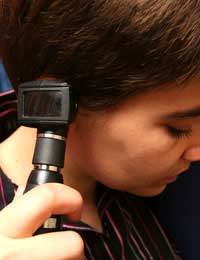Hearing Test Techniques

There are many techniques available that can be used to test your hearing and your doctor or specialist will select an appropriate testing method depending on what they think the problem with your hearing may be. In many cases the person themselves or those around them have noticed a change in hearing function which has indicated a visit to the GP in the first instance, though some, depending on medical history, genetic family history or because of their employment will require regular hearing tests and monitoring in order to detect any problems early on in its development.
Types of Tests
- Whispered Speech Tests. This type of test is a very basic testing technique and can be tried at home to discover whether there is any degree of hearing impairment. It is useful as an indicator of a problem that will require further testing by a specialist. All that’s involved is to simply stand behind the person being tested and whispering words or commands and finding out if anything has been heard or not. This test can be tried in the presence of background noise or without.
- Wide Band Reflectance. This type of test is used as a diagnostic tool for middle ear infections and has been designed to help doctors understand how changes to the anatomy of the ear caused by the infections, impacts hearing ability and why. It examines how the ear reacts and responds to sounds rather than just focussing on whether the ear can detect sound. It is a fairly new test and is still in its infancy.
- The Tuning Fork Test. This test is usually carried out in the audiology department and involves the use of a variety of tuning forks of different pitches and tones being struck In order to find out whether there is a difference in hearing ability of high or low pitched sounds.
- Otoacoustic Emissions. This test aims to monitor cochlea responses to sounds using a probe placed in the ear.
- Auditory Brainstem Response. Using specialist equipment, this test aims to measure the activity of the auditory nerve, cochlea and brain when a sound is heard.
- Pure Tone Audiometry. Sounds of differing pitches and volume are produced using an audiometer, and via headphones, the person being tested indicates by pressing a button when they hear a noise in order to discover their threshold. The sound is measured in decibels and each person will have their own threshold.
- Bone Oscillator. This test measures sound heard when it is sent through the bone instead of the air. A device is placed against the head on the bony part behind the ear.
Hearing tests are an essential part of looking after your ears. Regular tests will help to detect conditions early and may help to prevent hearing loss in the future. If you are concerned about your own or someone else’s hearing, please do not hesitate in making an appointment to see your GP.
- Do Ear Trumpets Work?
- What is Hyperacusis?
- Tiny Microphones Help Soldiers Hear in Battle
- Why Hearing Tests Are Important for Diabetics
- War Can Cause Deafness
- How Can I Check My Hearing?
- Can Genetics Explain Hearing Problems?
- Can Stem Cells Restore Lost Hearing?
- Recognising and Confronting Hearing Loss
- What Causes Deafness?
- What Types of Hearing Aid are Available Nowadays?


Re: Types of Ear Surgery
My child is born with deaf. So what should i do. Which treatment should i take to my child
Re: How Your Genes Shape Your Ear Lobes
My 2 month old has one free earlobe and his other ear has a half attached earlobe why? Should I be concerned?
Re: I Feel Dizzy and My Ear Itches: What Does it Mean?
I have noticed my ears are producing more sticky staff, itching and in the middle of last year I…
Re: Can Ear Wax Be Removed by Vacuum?
Vacuuming caused a 30% hearing loss. Don't allow it. Find a dr or audiologist who avoids it.
Re: Cysts and Tumours in the Ear
I had a pollock in my ear. can they regrow ?
Re: Grommets and Your Ear
@Ella - I'm afraid we can't give direct medical advice. The best option you have is to visit your GP and hope he/she will be able to help…
Re: Grommets and Your Ear
I had grommets when I was 2 and 5, a few weeks ago I found out I have scarring and 1 of my grommets are still in my ear meaning I had it in…
Re: Can Ear Wax Be Removed by Vacuum?
I had an ear wax removal procedure done at the Loma Linda, Ca Va facility. When the tech was vacuuming out the wax in my…
Re: Cysts and Tumours in the Ear
@CarrolA - I have no knowledge of your condition or what it might be. But if you want a quicker appointment, and peace of mind,…
Re: Cysts and Tumours in the Ear
I woke up one morning about five weeks ago with a feeling that my ear was blocked. A strange additional symptom is that every word…